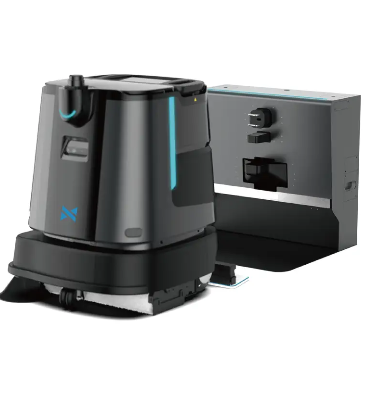Fitur Utama yang Perlu Diperhatikan pada Pemetaan Pintar Robot penyapu
Navigasi Laser vs Sistem Berbasis Kamera
Memilih robot vakum pemetaan pintar berarti harus memahami cara kerjanya dalam navigasi. Navigasi laser bekerja dengan teknologi yang disebut LIDAR yang mampu membuat peta cukup akurat dari ruang di mana pun alat ini berada. Robot-robot ini tahu persis di mana mereka berada bahkan saat bergerak di rumah besar dengan banyak ruangan. Keunggulannya adalah kemampuan untuk menemukan kembali lokasi tertentu secara berulang, sangat membantu di rumah di mana tata letak furnitur sering berubah. Sistem berbasis kamera bekerja secara berbeda. Sistem ini pada dasarnya mengambil gambar saat bergerak untuk memahami lingkungan sekitarnya. Meskipun mampu menghasilkan visual yang baik, sistem ini cenderung kesulitan jika pencahayaan tidak mencukupi karena membutuhkan titik referensi visual. Oleh karena itu, banyak orang tetap lebih memilih navigasi laser jika menginginkan hasil pembersihan yang dapat diandalkan kapan pun waktu pembersihan dilakukan.
Teknologi Pengenalan Ruangan Waktu Nyata
Kemampuan untuk mengenali ruangan yang berbeda secara real time telah menjadi salah satu fitur inovatif bagi robot penyedot debu modern. Mesin-mesin ini kini dapat membedakan antara ruang tamu, dapur, atau kamar tidur hanya dengan mendeteksi lingkungan sekitarnya. Apa yang membuat fitur ini begitu bermanfaat? Nah, ketika sebuah robot mengetahui di mana ia berada, ia menyesuaikan cara pembersihannya berdasarkan kebutuhan spesifik dari ruang tersebut. Lantai dalam rumah pun bervariasi—ada yang beralas karpet, kayu keras, atau keramik, belum lagi jumlah barang yang berserakan yang berbeda-beda. Coba lihat model-model populer dari perusahaan seperti Roomba dan Roborock yang telah mengintegrasikan kesadaran ruangan dalam desain mereka. Hasilnya? Lantai seluruh rumah menjadi lebih bersih karena robot-robot ini membuat rute khusus untuk setiap area, bukan sekadar mengikuti jalur umum tanpa memperhatikan kondisi kotor yang ada di depan mereka.
Kemampuan Pemetaan Rumah Multi-Tingkat
Rumah tangga dengan banyak lantai benar-benar membutuhkan pemetaan bertingkat yang baik jika mereka ingin robot penyedot debu mereka bekerja secara optimal. Saat sebuah robot dilengkapi teknologi pemetaan canggih, robot tersebut dapat mengetahui di mana setiap lantai dimulai dan berakhir, sehingga tidak sekadar bergerak tanpa arah. Pembersih pintar ini mengubah segalanya bagi orang-orang yang tinggal di rumah yang lebih besar, sesuatu yang tidak dapat ditangani oleh model-model lama. Menurut laporan industri yang menunjukkan peningkatan penjualan di segmen ini, semakin banyak orang mencari robot yang mampu menavigasi tata letak rumah yang kompleks. Yang membuat perangkat-perangkat ini menonjol adalah kemampuannya berpindah dari satu lantai ke lantai lain tanpa kebingungan, memastikan bahkan sudut-sudut yang sulit dijangkau tetap dibersihkan secara teratur.
Bagaimana AI Memperkuat Modern Robot penyapu
Algoritma Penghindaran Halangan
Sistem penghindaran rintangan yang didukung oleh AI benar-benar meningkatkan kemampuan robot dalam bergerak di ruang-ruang yang penuh dengan furnitur dan barang-barang lainnya. Dengan sistem pintar ini, mesin dapat mengenali halangan di jalurnya dan menemukan rute alternatif agar tetap bisa melanjutkan proses pembersihan. Penelitian menunjukkan bahwa teknologi ini membuat rute pembersihan lebih baik dan keseluruhan proses lebih efisien, membersihkan lantai secara menyeluruh tanpa bolak-balik di area yang sama. Bagi orang-orang yang tinggal di rumah yang selalu berantakan, terutama mereka yang memiliki anak kecil atau hewan peliharaan yang sering membuat kekacauan, navigasi pintar seperti ini sangat memudahkan kehidupan. Robot dapat menghindari mainan yang berserakan di lantai dan menjauh dari wadah makanan hewan peliharaan, melindungi barang-barang rumah tangga sambil tetap menjaga kebersihan dan kerapiannya.
Pola Pembersihan Berbasis Pembelajaran Mandiri
Robot vakum modern kini dilengkapi dengan kecerdasan buatan yang memungkinkan mereka belajar dari cara orang hidup dan tata letak rumah mereka. Mesin pintar ini semakin mahir dalam membersihkan seiring waktu karena mampu beradaptasi dengan kebutuhan dan ruang individu. Saat robot menghabiskan cukup waktu untuk bergerak menghindari furnitur dan memahami di mana debu cenderung menumpuk, robot tersebut mulai memetakan rute yang lebih cerdas demi efektivitas maksimal. Perusahaan seperti iRobot dan Shark, sebagai contoh, telah menghadirkan kemampuan belajar ini dalam model-model terbaru mereka. Banyak pengguna melaporkan bahwa mereka menghabiskan lebih sedikit waktu untuk pekerjaan rumah sejak memiliki perangkat semacam ini. Orang-orang senang pulang ke lantai yang lebih bersih tanpa harus mengarahkan mesin secara manual ke seluruh penjuru rumah. Beberapa bahkan menyebutkan noda debu yang sebelumnya tidak pernah tersentuh kini menjadi bersih setelah beberapa minggu dioperasikan. Jenis pembelajaran adaptif semacam ini merupakan terobosan besar bagi siapa saja yang lelah berjuang melawan penyedot debu robot tradisional.
Integrasi Kontrol Suara
Kontrol suara semakin populer di kalangan produsen robot penyapu yang ingin mempermudah kehidupan pengguna. Saat perangkat-perangkat ini dilengkapi asisten pintar seperti Alexa atau Google Assistant, pengguna merasa lebih mudah untuk memulai, menjeda, atau mengatur jadwal pembersihan hanya dengan berbicara keras-keras. Kemampuan untuk beroperasi tanpa menyentuh perangkat sangat diminati oleh masyarakat yang tinggal di rumah pintar modern, di mana segala sesuatu dari lampu hingga termostat dapat merespons perintah suara. Riset pasar menunjukkan bahwa semakin banyak rumah tangga yang mengadopsi teknologi pintar setiap tahunnya, dan perintah suara tetap menjadi salah satu fitur yang paling dicari. Lebih dari sekadar kenyamanan, perkembangan ini memberikan pilihan tambahan bagi pemilik rumah untuk menjaga lantai tetap bersih tanpa perlu mengangkat jari.
Pertimbangan Kinerja Utama untuk Pembersihan Berbasis AI
Daya Tahan Baterai dan Efisiensi Pengisian Ulang
Daya tahan baterai sangat penting saat melihat robot penyapu, terutama jika seseorang tinggal di rumah yang lebih besar. Baterai yang baik berarti robot dapat menangani area luas tanpa harus berhenti sering untuk mengisi daya. Robot yang dapat mengatur jadwal pengisian daya dengan baik dapat menghemat waktu dan menjaga operasional di sekitar rumah tetap lancar. Beberapa model terbaru dilengkapi dengan teknologi yang disebut 'isi ulang dan lanjutkan' (recharge and resume). Mesin-mesin ini akan kembali ke dok pengisian daya ketika dayanya rendah, lalu melanjutkan tugasnya dari titik yang sama setelah baterai terisi kembali. Teknologi ini membuatnya sangat berguna bagi orang-orang dengan denah rumah yang luas yang tidak ingin terus-menerus mereset alat pembersihnya. Berdasarkan umpan balik dari berbagai platform, Roborock S8 Pro Ultra menonjol karena daya tahan baterainya yang tahan lama. Banyak pengguna melaporkan bahwa robot ini mampu membersihkan seluruh rumah dalam sekali pengisian daya, menjadikannya salah satu opsi terbaik saat ini bagi mereka yang mengutamakan waktu operasional.
Penyesuaian Kekuatan Hisap Berdasarkan Jenis Permukaan
Teknologi pintar membuat robot vakum lebih mahir dalam melakukan tugasnya karena mereka dapat secara otomatis menyesuaikan kekuatan hisap tergantung pada jenis lantai yang sedang dibersihkan. Saat berpindah dari karpet ke ubin atau kayu, robot-robot ini tahu persis seberapa besar kekuatan hisap yang paling efektif tanpa bantuan manusia. Ambil contoh Roborock Qrevo. Model ini cukup baik dalam beralih antar berbagai jenis permukaan, memberikan tenaga yang cukup untuk karpet tanpa merusak lantai kayu yang lebih sensitif. Pemiliknya sering menyebutkan bahwa rumah mereka tetap lebih bersih dalam waktu lebih lama karena robot ini mengatur semua perubahan pengaturan tersebut secara mandiri. Tidak perlu lagi sibuk mengutak-atik tombol setiap kali berpindah ke ruangan dengan lantai berbeda.
Sistem Pembuangan Kotoran Otomatis
Pembuangan kotoran secara otomatis telah menjadi inovasi besar bagi robot penyapu, mengurangi keterlibatan manusia dalam tugas-tugas kebersihan. Teknologi modern memungkinkan robot vakum ini membuang kotoran yang telah dikumpulkan secara mandiri tanpa memerlukan intervensi manual. Ambil contoh Shark IQ Robot XL yang memiliki sistem bawaan untuk memindahkan puing-puing ke stasiun basis yang lebih besar saat kembali ke rumah. Konfigurasi semacam ini menyelamatkan pemilik dari kerepotan harus mengosongkan wadah debu kecil setiap beberapa hari, yang sangat nyaman bagi orang-orang yang ingin pekerjaan kebersihan dilakukan sementara mereka sibuk dengan hal-hal lain. Melihat tren pasar saat ini, angka penjualan menunjukkan bahwa fitur pembersihan mandiri semakin populer. Lebih banyak rumah tangga yang tertarik pada solusi yang membuat pekerjaan mingguan lebih sederhana, bukan sekadar menambah daftar tugas.
Tips Perawatan untuk Robot Penyapu Canggih
Praktik Terbaik Pembaruan Perangkat Lunak
Memastikan perangkat lunak pada robot penyapu Anda tetap terkini sangat penting jika Anda ingin agar alat tersebut bekerja secara optimal dan mendapatkan semua fitur baru keren yang terus ditambahkan oleh produsen. Saat perusahaan merilis pembaruan, biasanya pembaruan tersebut membawa sistem navigasi yang lebih baik dan cara kerja yang lebih cerdas serta bersih saat membersihkan rumah. Kebanyakan orang menemukan bahwa memeriksa pembaruan melalui aplikasi pendamping atau langsung dalam menu pengaturan robot merupakan cara yang cukup efektif. Beberapa orang juga melaporkan adanya peningkatan yang terlihat setelah memasang pembaruan ini – sebuah survei menemukan sekitar 60% pengguna merasakan kinerja robot meningkat setelah diperbarui, meskipun hasilnya bisa berbeda tergantung merek dan modelnya. Mengatur notifikasi push untuk saat pembaruan perangkat lunak baru tersedia membantu mencegah terlewatnya pembaruan penting, sehingga mesin tetap berjalan lancar tanpa gangguan tak terduga di masa mendatang.
Pembersihan dan Perawatan Sensor
Sensor pada robot penyapu memainkan peran penting dalam cara mereka bergerak dan mendeteksi rintangan selama sesi pembersihan. Namun, ketika debu menumpuk atau rambut menyangkut di atasnya, robot tidak akan bekerja dengan benar lagi. Kebanyakan pemilik menyadari bahwa mereka perlu membersihkan sensor tersebut secara rutin. Cukup dilap dengan kain microfiber biasanya sudah cukup, tetapi kadang kotoran membandel perlu ditiup dengan udara bertekanan agar benar-benar bersih. Menjaga kebersihan sensor ini benar-benar berpengaruh pada kinerja sehari-hari. Tanpa perawatan yang tepat, robot cenderung lebih sering menabrak benda, melewatkan area yang seharusnya dibersihkan, atau bingung menentukan arah yang benar. Beberapa pengguna bahkan mengalami robot berhenti bekerja sama sekali setelah berbulan-bulan mengabaikan perawatan dasar sensor. Oleh karena itu, penting untuk meluangkan waktu melakukan tugas kecil ini sebagai bagian dari rutinitas perawatan mingguan terhadap robot.
Pemecahan Masalah Kesalahan Pemetaan Umum
Robot penyapu terkadang bingung dengan lokasinya karena sensor mereka mungkin tidak akurat atau ada masalah pada perangkat lunak. Ketika kita mulai menyadari hal-hal tidak berjalan lancar, seperti saat robot kita terus-menerus melewatkan seluruh ruangan atau menabrak perabotan berulang kali, lebih baik menangani masalah tersebut sebelum menjadi lebih parah. Untuk memperbaikinya, kebanyakan orang menemukan bahwa menyetel ulang sensor membantu banyak. Kita juga harus memastikan tidak ada halangan di jalur robot saat bergerak di dalam rumah. Jika semua langkah tidak berhasil, melakukan reset ke pengaturan pabrik biasanya dapat mengembalikan semuanya ke kondisi normal. Melihat masukan yang dibagikan oleh pengguna lain di internet juga memberi kita beberapa ide bagus. Banyak pengguna menyarankan menghapus seluruh memori robot dan kemudian membuat peta baru dari rumah melalui aplikasi pendamping. Pendekatan ini umumnya lebih efektif dibanding mencoba perbaikan secara acak. Mengambil langkah-langkah ini sejak awal membantu robot tetap berjalan lancar dan menghindari masalah yang sama berulang-ulang.
FAQ
Apa perbedaan antara sistem navigasi LIDAR dan berbasis kamera pada robot penyapu?
Sistem berbasis LIDAR menggunakan teknologi laser untuk pemetaan dan navigasi yang presisi, bahkan dalam kondisi cahaya rendah, sementara sistem berbasis kamera bergantung pada data visual, yang mungkin terhambat dalam lingkungan yang lebih gelap.
Bagaimana AI meningkatkan kinerja robot penyapu?
AI meningkatkan kinerja melalui algoritma penghindaran rintangan, pola pembersihan pembelajaran mandiri, dan penyesuaian otomatis, yang mengarah pada sesi pembersihan yang lebih efisien dan menyeluruh.
Mengapa integrasi kontrol suara penting dalam robot penyapu dengan pemetaan pintar?
Kontrol suara memungkinkan pengguna mengelola sesi pembersihan tanpa menggunakan tangan dengan asisten pintar, menawarkan kemudahan dan kenyamanan dalam terhubung dengan perangkat rumah pintar.
Apa pemeliharaan yang diperlukan untuk kinerja optimal dari robot penyapu?
Pembaruan perangkat lunak secara teratur, pembersihan sensor, dan penyelesaian kesalahan pemetaan sangat penting untuk memastikan kinerja dan umur panjang robot.

